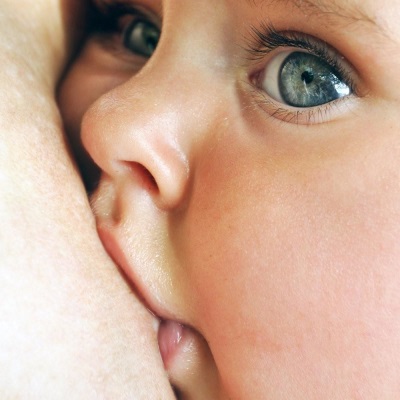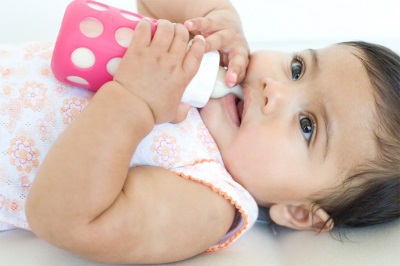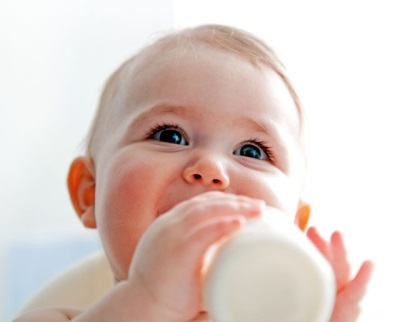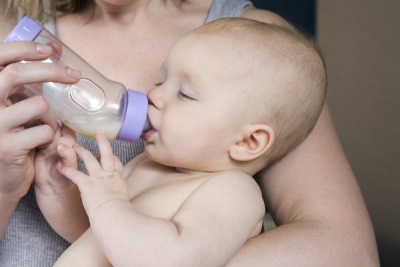How to organize a mixed feeding baby?
If a child gets both mother’s milk and a mixture at the same time, this feeding is called mixed. With this type of feeding, the proportion of the mixture in the baby's diet is from 20% to 50%.
In the case of this type of feeding, feeding can be organized in two ways:
- First give the breast, and then finish feeding the mixture.
- Completely replace any feeding mixture.
It is recommended to choose the option in which the mixture will be consumed less, that is, the baby's mother's milk will receive more.

The reasons
- Most often, mixed feeding is transferred in case of insufficient production of breast milk. Often, a lack of milk is a far-fetched problem, caused either by the subconscious reluctance of the mother to breastfeed or by the low awareness of the woman about the lactation process. However, there are also objective causes of hypogalactia, forcing mom to resort to dokormu.
- The second reason for the combination in breastfeeding the baby and the bottle is that the mother goes to work or study. Often, the mother leaves the expressed milk for the time of absence, but more often when the mother is working, the child is fed with milk formula.
- The doctor recommends a mixed type of feeding when the baby is not gaining enough weight or is born prematurely. In this case, this type of feeding is a temporary measure - gradually feeding becomes completely breastfed.
- Also, mom can start to finish feeding the crumbs from a bottle in order to free up some time for herself. In this case, the child can be left with the husband or another adult for a short time, without worrying that the baby will remain hungry.
- Another important reason for feeding the infant with the mixture is that the mother has diseases in a compensated form.

pros
- With this type of feeding, the mother may be temporarily replaced by another adult, but at the same time she will be able to maintain intimacy with the crumbs during breastfeeding.
- The child has all the benefits. breastfeeding.
- Mom may be away from the child for a while.
- Mixed feeding can help dad to establish a closer relationship with the baby.
Minuses
First of all, because of the missed feed, the mother may have problems with the breast (congestion, milk flushes, chest pain and even mastitis) and lactation. Mom can also psychologically suffer from the fact that the time of breastfeeding has decreased.
At the same time, it may be difficult for a child to adapt to two types of feeding at once:
- He may refuse bottle feeding and be naughty. His appetite may be reduced.
- Starting with ease to get the mixture from the bottle, the baby does not want to "work", extracting milk from her mother's breast. This happens during a very early transition to mixed feeding (in the first 6 weeks of a baby’s life).
- Often having lost the breast during the day, the baby begins to demand more breast milk in the evening and at night.
Which is better: add the mixture to the feed or fully translate into it?
The digestive system of the baby is tuned to breast milk, and when the mixture gets into it, various unforeseen reactions are possible. Therefore, we must especially closely monitor the reaction of the baby.
It is important to understand that the mixture, even if it is expensive and of the best quality, is not equal to breast milk. Therefore, to abandon breastfeeding is not necessary in any case. It is easy to relate to the finishing of the mixture, you should not choose a mixture without consulting a doctor. Also, the decision of the mother to feed the crumbs with goat milk or kefir can only harm the health of the baby.
rules
- If the mixture and breast milk are given in one feeding, then at first the baby is applied to the breast (even if the mother has very little milk), and when the child empties it completely, the mixture is given. The reason for this approach is to have a greater appetite in the infant at the beginning of feeding. If you give the mixture first, the mother will find it difficult to calculate the right amount, and the child will not want to suckle to get milk, since he has already satisfied his first hunger.
- In situations where the mother will be temporarily absent during the day, the baby is transferred to a mixed feeding regime in which the baby will receive only the mixture two or three times a day, and only mom's milk in the other feedings.
- If the volume of the supplement is small, it is recommended to give the mixture from a spoon, since, due to the easier delivery of the product from the nipple, there is a risk that the baby will not suck from the breast. If the mixture is given in a large volume, it is important to choose an elastic nipple, which has small holes so that the infant makes efforts to obtain a mixture from the bottle.
- Diet with this type of feeding can be free, but if the mother decides to feed the baby on a schedule, the number of feedings can be reduced by one.
- It is important to carefully monitor the sterility of the bottles and nipples.
- If the mother goes to work, you should not put off the first attempts to feed the baby from the bottle for the last days. In most cases, infants are not immediately put up with bottle feeding. It is optimal to start feeding the infant with the mixture for 2-3 weeks before the moment when the mother begins to leave the house for a long time.
- When mixed feeding a child, you can begin to feed up for two or three weeks earlier than a baby who receives only breast milk.

Requirement calculation
If you have the opportunity to provide your baby with the required amount of milk per feeding (when cutting back on their total amount), use this opportunity and give the mixture only one feed. In this case, it is possible to calculate only the amount of the mixture required for the current feeding of the infant mixture.
To determine the infant's nutritional needs, consider the age of the crumbs and the type of mixture used.
First, calculate the total daily infant nutritional need:
- a child under the age of 10 days with a weight of less than 3200 g should be multiplied by 70 by the age in days to calculate the required amount of food (if weighing more than 3200, multiply 80 by the age in days);
- a child under 2 months is given food in the amount of 20% of its body weight;
- children from two to four months require food in the amount of 1/6 of their weight;
- babies older than 4 months to 6 months of age need nutrition in the amount of 1/7 of their body weight;
- Children from six months to a year need a daily intake of food in the amount of 1/8 to 1/9 of their weight.
The total amount is divided by the number of feedings and we know the approximate amount of food needed by the baby in one feeding.
The amount of sucked milk can be measured by control weighing: weigh the baby before feeding and then after. After subtracting these values, you will know the amount of milk consumed. Now it only remains to take away the volume of breast milk received by the infant from the total volume - this way mom finds out how much baby needs a mixture.
To make sure that the baby has enough for the growth and full development of all nutrients, you need to calculate how much the child receives proteins, carbohydrates and fats daily. The calculation is based on the rates of entry into the children's organism of the main nutrients, as well as the approximate content of these substances in human milk.
Child's age (months) | Squirrels | Fat | Carbohydrates |
From birth to 4 | 2-2.5 g / kg | 6-6,5 g / kg | 12-14 g / kg |
4 to 9 | 3-3.5 g / kg | 5.5-6 g / kg | 12-14 g / kg |
From 9 to 12 | 3-3.5 g / kg | 5-5.5 g / kg | 12-14m |
In breast milk | 1.3 g per 100 ml | 4.2 g per 100 ml | 7 g in 100 ml |
First, it is calculated how much the baby gets all the breast milk per day, and then how much protein, carbohydrates, and also fats he gets with this diet. Further, the content of nutrients in the resulting volume of the milk mixture is also calculated. Having calculated the needs of the little ones, depending on their age, they determine whether the crumbs of the food they receive are sufficient.
At the same time, it should be noted that the protein requirements increase when mixed for feeding to the infant. A baby under 4 months for each kilogram of mass requires 3 grams of protein, if supplementation is carried out with an adapted mixture, and 3.5 grams, if the mixture is not adapted. A child older than 4 months requires 3.5-4 grams of protein.
What do they feed?
For the supplement, choose the same mixtures that are recommended to be fed on artificially fed babies. Preference is given to the adapted mixture.

What can not be fed?
Baby should not be given a medical mixture, if it is not recommended by a pediatrician. For the use of mixtures with a therapeutic effect, there are strict indications, for example, the soy mixture is given for allergies to milk protein, and lactose-free is used in crumbs with a lack of lactase. Kefir, cow or goat milk can significantly harm the body crumbs.
If the child does not like the bottle
Many babies do not want to move from breast feeding to bottle feeding. To make this transition more successful, my mother is recommended:
- Try to put on the bottle nipples of different types, so that the baby can pick up "his."
- The first time to feed bottle of expressed female milk.
- Feed from a bottle at a time when the crumbs want to eat, but the baby is not too hungry.
- Let the first time someone else offer the bottle to the baby, not the mother.
- When the baby is fed with the mixture, let the baby be in a position not in the position in which he was accustomed to getting his mother's breast.
- The liquid that is given to the baby should be warm, since the crumb used to get milk from her mother's breast in the form of heat.
- We should not expect that the baby will immediately drink the entire mixture from the bottle.
- In extreme cases, the mother will not have to give the baby a breast all day long, so that the baby still agrees to try the mixture from the bottle.
- If the baby persists and he has already turned 6 months, it makes sense to plan for the time of the absence of the mother feeding the baby complementary foods.
We advise you to read our article about how to teach a child to the bottle.

If the baby does not take the breast after the bottle
Unfortunately, starting to receive food from a bottle, in most cases, children do not want to suck their mother's breast anymore, since it is more difficult for an infant to “get” milk from the female breast than to suck the mixture through the nipple, while others use muscles from the nipple.To begin with, try to pick up a nipple with a small hole or with only 1 hole, perhaps this will help to keep feeding mixed.
If the mother wants to return breastfeeding, she will have to give up the bottle and give the little one the opportunity to get hungry well. Otherwise, it is capable of helping out the decanting and feeding of women's milk from a bottle. Either it will remain to put up with the final transition to feeding with the mixture.
Opinion E. Komarovsky
Famous pediatrician, if necessary, transfer crumbs to mixed feeding recommends giving preference to a product that is more important for the health of the child. Komarovsky, like other pediatricians, considers her mother's milk the most valuable food for babies.
In cases where the mother is forced to give the crumbs some more nutrition, the woman should choose a feeding regime where the baby will consume more breast milk. Mom can give each breastfeed baby at first a breast, and then finish feeding with an adapted mixture, or give only a mixture to one of the feedings.











